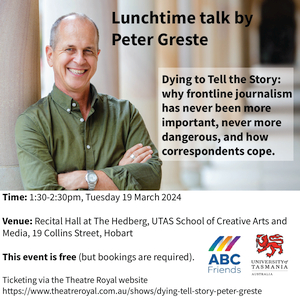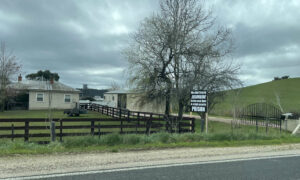PHOTO by Kim Peart of the Ross Bridge and the Uniting Church on the hill.
One of the most amazing finds in science was made in 1929, when the astronomer, Edwin Hubble, found that the Universe was expanding.
Hubble observed that galaxies were moving away from the Milky Way, and the further away they were, the faster they were moving away.
This effect was not due to the movement of the galaxies, but to the expansion of space, an expansion that continues and is currently accelerating.
Following the obvious trail, cosmologists wondered how small the Universe could have once been.
The conclusion was that our cosmos began as an infinitely small point 13.8 billion years ago, that then began stretching to infinity in an event called the Big Bang.
Another astronomer, Fred Hoyle, favoured his theory for a steady-state Universe, and called the exploding singularity the Big Bang, as a joke, in a BBC radio interview on 28 March 1949.
Maybe one day the science creation event of the Universe will be revisited and granted a more poetic name, but for now we are stuck with Fred Hoyle’s joke.
The stretching of space means that everything in the cosmos is within a primal expanding cosmic singularity.
To understand the Universe, is to appreciate that there is a cosmic oneness that is primal to existence.
In life we can see ourselves as separate, but that is an illusion of the cosmic play that we are in.
Our underlying reality is that we are part of the oneness of the primal singularity that stretched to infinity.
On the one hand this property of space and time may permit instant communications between the stars.
On the other hand, we each have a primal connection to all space and time, where space and time are two sides of the same coin, as there cannot be space without time, nor time without space.
In the practice of meditation there is an appreciation of the primal cosmic oneness, with the meditator’s aim to be in harmony with the oneness of everything.
The mind must be still and calm, like the water of a pond that reflects the Moon and stars above.
This calmness leads to peace of mind and a mental state of equanimity.
In meditative cosmic oneness, there is an embracing of the infinitely small beginning of the Universe that expands to infinity.
The meditator seeks to be in harmony with cosmic expansion, to be part of all space and time, and also in the singularity at the birth of the cosmos, in the heart of the Universe.
In cosmic oneness, there can be an appreciation of a transcendent realm beyond space and time.
Cosmologists refer to the transcendent environment as the multiverse, where there may be an infinite number of other universes, floating like bubbles in the ocean.
This has long been a view of the meditator, seeing the transcendent realm as an ocean of bliss, in which the Universe exists as a bubble, taking form for a time like a womb for life.
The transcendent reality is the ocean multiverse, which is where we really are.
To answer that prime question “Who am I?” it helps to let go of all that is known, to be empty and wonder about cosmic origins.
To wonder, where did the Universe begin?
In a stretched cosmic oneness, we each occupy the space where time and space began.
Being in cosmic oneness, it is possible to realise that we are also in the transcendent realm, though it may not be seen with our womb eyes, and from within the cosmic womb.
Ultimately, the meditator sees the need to be born from the illusion cosmic womb, to be in the reality of the ocean multiverse, the ocean of bliss.
Being open to an existence that is vaster than the Universe, is to begin to find “Who am I?”
If happiness is the highest quality that we can experience in life, then happiness may be the beginning quality that transcends the Universe.
In happiness we may find “Who am I?”
In a meditative journey based on science, the proof of the experiment will be in the experience.
Happiness can happen when we let go of all that is not happiness, and allow ourselves to be happy.
If happiness is a natural experience of the transcendent realm, then we can allow ourselves to be happy as a natural experience.
The qualities of the transcendent realm fill the cosmos, which we can rise to in meditative experience, and in being alive.
We can seek to be loved, and we can give our love, as we must when raising a child, but we can allow ourselves to be happy as a natural experience.
Excitement, love and the experience of beauty in nature, music and art, are agitations of energy.
Only by attuning to the cosmic oneness, is it possible to be in the happiness that transcends cosmic oneness.
Being in cosmic oneness, and in happiness, is to capture the spirit of equanimity.
In equanimity, serendipity can reveal unexpected discoveries.
Sometimes, it helps to stop thinking, to see what is real.
And discover “Who am I?”
AN EARLIER VERSION of this article first appeared in Star Challenger, the Space Pioneers newsletter.
ABOUT KIM PEART ~
*Kim Peart was raised in Howrah from 1952 and had a safe childhood in a loving home, building sandcastles on the beach, playing in the bush of the hills above, making bonfires for cracker night, visiting the mysterious Fort in Bellerive, riding the old ferries across the river and going to the movies in old theatres. After an inner experience of happiness at age 24 in Chequer’s Coffee Lounge in Hobart, Kim explored Eastern meditation in the 1980s, made a journey to India and after some years behind bars with a studio in the Salamanca Arts Centre, moved to Murdunna where a sense of being in Nature was found; like a rediscovered childhood, Kim came to feel the life-force of the Earth flowing like blood, of being part of the body of Mother Nature. In a transcendent view of life, Kim now pursues art and history in Ross, where he lives with his wife Jennifer, seeks ways that we may live in harmony with the Earth, and sees the need for human civilization to expand beyond our birth planet, if we are keen on basic survival. Meditation is natural, whether on Earth, or in deep space, when in harmony with the cosmic ocean, where stars are islands.



























PHilip Lowe
March 28, 2017 at 21:58
no,you wrong there.It was all made by Allah.A bloke down at Hyde Park Corner told me all about it.(removes tongue from cheek and exits stage left).
Kim Peart
March 29, 2017 at 13:03
Science delivers some interesting details to explain how the cosmos works.
We accept that space is 3 dimensions and time is a 4th dimension.
We look toward smarter computers using quantum mechanics.
If we delve too deeply into the quantum realm we can read that 7 more dimensions are needed to explain how the Universe works.
Then we are confronted by the singularity at the beginning of time as in infinitely small point that stretched to infinity.
We can then wonder if the end of the Universe is essentially nothing, and the beginning of the multiverse, or transcendent realm, is on the other side of nothing.
This matches meditation instruction, to still the mind and be open to that which is beyond space and time, the transcendent realm.
So we must drop laws to let go of thought and be in a realm that transcends the cosmic womb that we are in.
Like a baby in a womb, we cannot see reality, and when we leave the womb, what could we tell a baby in a womb about the outside world.
If this experience in life compares to the cosmos and the transcendent realm, then we cannot expect to know anything beyond the cosmic womb with womb thoughts.
If the transcendent is other, then we must let go of thought, to be open to that other experience of life, where happiness may be the beginning of much more.
So, if we did have an experience of the transcendent, there are no words in the cosmos that could describe the experience.
It is other.
So wondering who made the Universe is a folly, and is beyond thought.
Like allowing ourselves to be happy, we can suspend thought and allow ourselves to be who we really are.
If we are of the transcendent realm, and that is our primal reality, then we can simply let go of all that is not real, that is not of the other, that is not of the transcendent realm, that is not beyond thought, that is not light, that is not happy.
Just as the birth of the Universe was brilliant light emerging out of a singularity, that is a hint.
As space-time is a stretched singularity, the birth of the Universe is in the heart of us, when we acknowledge that primal reality of the cosmos.
In the light that is within, we can be, and be happy to be.
Pete Godfrey
March 29, 2017 at 14:39
Kim as a child I used to lay on my front lawn at night looking at the stars. I used to wonder about the universe, if the universe was infinite what was outside it. What lies beyond the stars is fascinating still. Pondering infinity is a challenge to the mind, It is like a koan, an impossible intellectual task.
Kim Peart
March 29, 2017 at 16:17
Re: 3 ~ I like the terms infinity and eternity ~ the finite space-time and the timeless mystery ~ the descendent Universe and the transcendent multiverse.
We can appreciate the 4 dimensions of space-time OK, but what would the 5th dimension of quantum mechanics be like, or the 11th?
So the Universe is a complex place full of puzzles, including relativity effects and the sheer size of the place.
Yet, science now speaks of a vaster realm, which science cannot describe, but must consider.
But is the vaster realm more complex than the Universe, or is it other.
The laws as we know them are a creature of this Universe, and we cannot say that they operate in the vaster realm.
Science cannot know this and cannot say much about it, because science is based on natural law, and natural law is confined to our cosmic home.
This is were other traditions may hold the keys, that look to other ways, beyond thought, and in happiness, where we can be in the vaster realm, and be free to be there.
Being in the transcendent awareness brings a different focus to any matter with the Universe.
From a transcendent perspective, the Universe begins as a singularity, a oneness that expands but remains one, so the Universe is simply there.
Standing at the foot of a mountain, we may be overwhelmed by its size, but in oneness, we are the mountain.
So in oneness, we are also the Universe, so to be there, it is not so daunting to reflect on the body of space-time.
We do not approach our body as a cell, or as an atom, but accept what we are as a whole.
Reflecting on oneness and holistic thinking are comparable disciplines that both raise awareness.
We can investigate details of our body, or of the Universe, where we come to understand details.
We can hold an overview of the whole system, whether our body, or the Earth, the Solar System, or the Milky Way.
In an appreciation of oneness, we can reflect on our body, and the landscape of our mind, and also the cosmos, which in oneness, is our larger body.
That view of oneness is derived from basic science, but also gains mention in ancient writings.
Pat Hogen
March 29, 2017 at 17:45
I am that, which, I am becoming!
Simon Warriner
March 29, 2017 at 18:08
Isn’t the ultimate objective of Yoga the development of the ability of one’s consciousness to become as one with the universe? Isn’t that why those who master Yoga choose the time, place and mode of their own departure from this mortal plane?
Wouldn’t that be the ultimate mode of space travel?
Interesting discussion, thanks for putting it out there.
Kim Peart
March 30, 2017 at 09:51
Re: 6 ~ There are a couple of matters here.
I have wondered if quantum entanglement, which allows a particle to be in two places, even on opposites sides of the Universe, will allow instant communications between stars, once we have reached another star system.
If we can communicate between two stars, we are sending information, so I wonder if this could include a form of teleporting of a person between stars, which would allow instant star travel.
I do not know much about the practice of yoga.
With simple meditation there is an appreciation of the other, beyond thought, the transcendent realm, which may be the same as the speculated multiverse in cosmology.
For the meditator, we are in the transcendent realm now, as it is our underlying reality, in which the Universe exists like a bubble in the ocean.
The primal quality of the Universe is oneness, with the cosmos being a singularity, or infinitely small point, that stretched to infinity.
If our reality is transcendent, like the sleeper in the Matrix movie, then being in harmony with reality must imply that we are also in tune with the oneness of the cosmos.
In this oneness, we are connected to all parts of space and time, so there would, in essence, be no limit to what parts of space and time we might focus on.
I wonder if the qualities required to be in harmony with reality raise the awareness of the individual.
In this awareness, attuned to a transcendent reality, a person’s focus would be drawn to the more interesting transcendent environment.
Having been born out of the womb, who seeks entry back into the womb?
There may be potential for negative power, but that would be a dead end, trapping the individual in the cosmic womb like a fossilised foetus.
If the dawn of reality is happiness, a person allowing happiness to flow through them as light, will be interested in how other people can also be happy.
This simple compulsive happiness will seek to help, where possible, like Simpson with his donkey at Gallipoli, or the story of the Good Samaritan.
Would anyone make such sacrifice if they were not happy being there?
We don’t have to love being in difficult places, but we can allow happiness to flow through us, which is from within.
That is natural, and can be allowed, if we have a primal connection to reality via within.
Science tells us that, as the cosmos is a point that stretched to infinity, then the place where all began is within, and as space and time are two sides of the same coin, the heart of us is where the Universe was born, and is also our escape route to reality, our birth canal.
When anyone has ripped this gateway open, they will be beyond fear, and they will be compassionate.
The prime interest will be matters like a Fair Go for all citizens, getting a Bill of Rights introduced into Australian democracy, shifting fiscal gears in this nation so that there is real work with real pay for all able workers, ensuring all citizens can be happy with good health, fighting for a healthy environment, seeking ways for human society to be a sustainable presence on this planet, investing in cosmic survival when we can do that, and simply being happy, because that’s easy to allow to flow from within like light.
What if a political movement arose of people who walked the ways of fearless compassion?
What would the World become?
In this happiness, laughter is spontaneous, and it is possible to get the joke that is called life in a cosmic womb.
Derbytas
March 31, 2017 at 15:39
What if…the universe was a cell and it was made up of molecule like galaxies and the galaxies, like molecules, were made up of atoms like a sun system is made up of electron like planets with a solar nucleus?
What if we are living on an electron.
What if we were within God and God was within us and we were all Gods and everything was infinite and inside us were uncountable universes and infinity went up and infinity went down and infinity was all around and within us all.
What organ is our cell like universe part of?
Which organ in Gods body are we part of and how many universes are there in this organ of God and how many universes are in that Gods organs.
How many Gods on the planet that our God inhabits and how big is that universe and how many universes are within each of those gods
And how little is just one of the universes I am made of. Which one has 7 billion gods on just one of those miniscule planets in it.
And what do they expect me to do about anything?
Pete Godfrey
March 31, 2017 at 20:44
#8 Derbytas, yes it does seem that the microcosm and macrocosm are the same only different scales.
I often think that we are in one of those little snow domes on God’s kitchen table. Every now and they some child picks us up and looks in, gives us a bit of a shake and then puts us down.
I still find pondering infinity a challenge to the mind.
If the universe starts out as a singularity, surrounded by whatever (be it empty space) then empty space has to be infinite. Sorry infinity just doesn’t cut it with the way my brain works. It is just tad too vast.
Duncan Mills
April 1, 2017 at 10:00
Congratulations all on a beautiful and lucid reflection.
More specifically and practically. It is the common dissonance between espoused values and action on this planet that is a prime challenge.
How might we restructure our everyday social life and our institutions to allow for more reflection on our shared values and how our actions live them out?
Kim Peart
April 1, 2017 at 10:12
Re: 9 ~ I am interested to see patterns, such as how the laws of the Universe were in full working order at the beginning of time, governing the forming of matter, the firing up of stars, and forming of planets, the emergence of life on third rock, human evolution, and the technology that spins off our hands, including robots, and now the spectre of artificial intelligence (AI).
It will help us to get our heads around root causes and where the show can go, on Earth and in space, as it is now pretty bleeding obvious that our show has no apparent limit in the cosmic home.
But there may be limits that kick in for reasons we can’t see yet, and it would be good to be prepared for that.
One limit could be extinction, if we will not run to survive.
Another limit could be finding our way to the next level of evolution as a mature stellar species, where we will mature at a higher level of consciousness and learn to care for life.
It may be this higher level of consciousness that will allow us to work with AI, rather than ending up in a machine war on Earth.
The whole cruel catastrophe of the Centrelink robot is a good life lesson and example on where the war with the machines can begin.
We have become abusive with life on Earth, demanding too much from one planet, yet it may be the forces of Nature and evolution that drive us. We need to grasp what it is we need to be doing within Nature, to end our abuses. We need to ask, “What does Nature want?”
Getting an answer to that question, will help us to understand who and what we are in this cosmic womb, and what it is we should best be doing, on Earth and among the stars.
Many people are terrified by what we can do, like Alvin Toffler’s Future Shock, but being terrified is a recipe for death in Nature. We must find our nerve and confidence to run in this Universe and survive. When we run to survive, then we may find what we should be doing, and who we are, really.
continued …..
Kim Peart
April 1, 2017 at 10:36
Re: 9 ~ continued …..
That lizard running across a beach from a hundred hungry snakes has no time to stop and reflect on breakfast, or where dinner will come from. That lizard must run and reach safety, to find the reflection space.
We must learn to run for safety, to a space where we can survive to reflect.
We cannot continue as we are on Earth, but we are not changing.
We are not running for that safe space.
It is interesting that where we are in the cosmos is around the centre of complexity, looking down to the subatomic, and looking out to the cosmic.
We do not have to think about that to run to the survival space, but the information is there.
I find it interesting that when we reached the limit of our sustainable presence on Earth the 1980s, was also the same decade when we could have been building beyond Earth and reducing our abuse of life on this planet.
Anyone interested can examine the archives held by NASA, the NSS, and the Space Studies Institute, to see what was possible in the 1980s.
We can also examine how we stopped running to a safe space on Earth, getting more unsustainable, getting more abusive of life.
We lost our nerve, we lost our confidence, and we lost our will to survive.
Now the nations are eyeballing 1.5C as a planet temperature rise that we should not pass. But to avoid passing that, we need CO2 in the air below 350 ppm, a level passed in the 1980s.
A convergence that we missed.
When I see this information, I see how we should have kept running to a safe space, and how now we have gotten ourselves caught in the coils of a carbon dragon that will deliver our extinction on third rock, if we will not escape and run to a safe space.
Convergenses that are limits in one place, or evolutionary opportunities in another space.
continued …..
Kim Peart
April 1, 2017 at 11:18
Re: 9 ~ continued …..
When we can accept the oneness revealed in physics, that the heart of the cosmos is within us, no matter where we are in space or time, then in our reflections we can be anywhere in the Universe.
When our body works well, we don’t worry, but when it doesn’t, we seek a doctor to fix the problem, such as a broken heart, and take the pills to keep the blood pressure down.
When our happiness works well, we don’t worry, but when it doesn’t, we may need another kind of doctor, one that shows us how to allow ourselves to be happy, as being happy is just natural, and we can allow that.
When our survival works well, we don’t worry, but when it isn’t working, like now, we need to get serious about that, or risk the extinction of our species. And we also present a threat to the survival of life on this planet, which can now continue if we vanish (due to released carbon as CO2 remaining aloft and warming up the Earth, which then releases more greenhouse gases, causing a runaway greenhouse effect).
We can be frozen in fear, because we do not see what to do. Being frozen in fear is a really rotten recipe for survival.
It helps to appreciate the meaning of the transcendent realm, and also get our heads around primal survival.
When we know that energy can change form, but not be destroyed, and that we are made of energy, then we can consider that we are part of processes that continue through cosmic space and time.
We are formed of energy that cannot be destroyed, so how that plays out with who we are is a matter of interest.
If we are reborn in life after life, then we have a larger existence to account to. If rebirth is fact, then we are faced with lessons to learn.
If rebirth is fact, then we can live beyond fear, know we continue in life beyond death.
We do not have to know past lives, or future lives, to be the best that we can be now.
We are, so we can be, and that is our choice.
Once we accept that there is a larger transcendent realm, which we are naturally in, then we can accept that, and if we wish, seek out the viewing instruments to look and see what is there.
Ancient meditators found that we are the viewing instrument to the transcendent realm, which is captured in oneness, focused in happiness, and open to other.
As the Universe is a pretty amazing place, naturally the transcendent realm, or multiverse, is a far more amazing space.
But we cannot see beyond the cosmic womb by looking out with our eyes.
We can begin to see by searching within, with a happy heart, beyond thought, open to other, and be beyond oneness.
Gaining happiness, allowing an appreciation of where we really are in a transcendent realm beyond this cosmic womb, we can be free of fear.
In life we are at an evolutionary fork in the road, where we face survival or extinction.
We can face the decision of the road without fear, and consider what is best for survival.
The art of fearless compassion is now badly needed, matched with the will to survive and run to a safe space.
One way or other, according to the meditators, we continue in this cosmos, but it would look better on our cosmic record if we figured out how we can allow life on Earth to continue, as we run for the survival safety of a space to reflect.
Finding “Who am I?” can reveal our primal responsibilities in life.
Kim Peart
April 1, 2017 at 11:44
Re: 10 ~ I did the personal work, and that continues, and then came the planet work, and waking up to the detail that if we are not running with survival, we are playing Russian roulette, and the more time that goes by as our survival risk grows, the more bullets in the gun.
Yes, we are working toward that point in time the that gun will be full of bullets.
When we decide to stop playing Russian roulette, focus on the demands of survival, and get our head together, then we stand a chance of saving the Earth, saving ourselves and offering a future for our children.
Our current approach to life and survival is a miserable failure, where we play games like Russian roulette.
When we can see that, then we can step back, identify the path that we aught be on, and figure out how we go there.
In going there, we will also be able to get our head-space in order, because we will be living more honestly with life.
I have another article up in the Tasmanian Times at present, exploring what we can do to live more honestly with life, and run with survival ~ Sustainability is a Two-Edged Sword.
Being happy is the easy part, which anyone can allow to happen.
Is that were we need to begin, to empower ourselves with the liberty of happiness, so that we build a society around us that runs with survival, cares about Nature to the point of being sustainable, and has compassion ship-shape, so that our society is fair to all.
If we want, we can build a global society without poverty, where every child can enjoy a healthy and creative life.
We haven’t got such a society now, so how do we get there?
Being able to describe the shape of that society, and how to go there, is the challenge we now face, if we would like a happy society on a healthy home planet.
We may need to run a workshop on how to stop playing g Russian roulette with a loaded gun.
Derbytas
April 1, 2017 at 13:11
AAAhhhsays me in a reflective manner. No wonder I resonate with you two guys.
I worked this one out when I was at highschool and heard of atomic physics for the first time. It is just like the universe says I; and it is how I am made up…its all the same.
This understanding encompasses all and answers all the questions the quantum guys pose. They still believe the universe is all we have. Where do black holes go etc?…mate it is all part of some cell that is so big we do not have the equipment to see it let alone understand it. We will seriously impede the ability of one electron to function properly but in the big scheme of things it matters little. On the other hand, in the little scheme of things it is a huge disaster, we will be wiping out infinite numbers of universes and more in one hit…so I suspect that it all stays in balance anyway.
I used to wonder where all these new souls came from everyday. we are up to 7 billion or more of them now. Who produces these new souls? and why?
Now I can see that it is all part of the infinite expansion of universes big banging away. No wonder the noise pollution is send many people crazy and disturbing the equanimity of the rest of us.
But annica, give it time. They say it may all balance out in 9 years or less. Whatever. I do what I do because that is what I do.
Derbytas
April 1, 2017 at 13:53
Pete, what I am proposing is that mabe the universe is just a cell in an organ in a body of a being (we call that being God.
Space as we conceive it is just the space between cells that make up the organ in that body.
maybe inside us, inside one of our organs is a cell in which there is a molecule in which there is an atom and on one of the electrons of that atom there are 7 billion little tiny people pondering how it works…their perception of their universe goes no further than the end of their cell because of that scale is as far as they can see. To them we are their God.
Kim Peart
April 2, 2017 at 10:48
Re: 16 ~ A good example of how to approach reality can be seen in the different world-view introduced with relativity.
Laws that were believed to run a clock-work universe, were revealed to be quite elastic, allow us to travel faster into the future by travelling faster in space.
Even two satellites above Earth must take relativity into account, to keep accurate time between them.
Physics went quite bizarre with quantum mechanics, allowing a particle to be a wave, or a wave to be a particle, but never both at the same time of observation.
Cosmology defines the need for the cosmos to stretch from nothing to infinity, to explain how it exists, and why space is expanding.
We can follow the bizarre world of the new physics to a point, but who can grasp the function of an 11 dimension universe.
Yet, that is the cosmos that we are in.
Unexplainable, or maybe just explainable.
Now we are faced with the multiverse, which is beyond the laws of our universe, which cannot be seen or observed, but must be considered to explain how the cosmos exists.
So we are faced with a mystery, with other, with a realm that is beyond science, beyond thought, beyond words.
Until cosmologists deliver some kind of observation of the multiverse, which may never happen, we have no words to explain the mystery of the other, of the transcendent realm.
Being beyond words, the only way to approach the multiverse is without words, free of thought, and open to the other realm on whatever term they be.
Having defined that the gateway to the other is within, we have a direction.
Knowing that the heart of within, the beginning of the Universe in terms of stretched oneness, is simply bright light, we have a condition.
Reflecting on the highest qualities of life, with happiness free of thought, we have an experience.
With the practice of meditation, being silent in light and happiness, we have a method of observation.
The ancient meditators say that we may have an experience of the other, but when we do, we will find no words to describe the experience of other.
The word “God” cannot be used to describe the transcendent realm, because “God” is a word, and words are trapped within the cosmic womb.
So God is a creature of the cosmos, the sum of natural law, the mother when a mother is needed, the farther when a father is needed, the light when light is entertained.
The best we can do is to be happy, and allow others to also be happy, in a fearless kind of way.
To take that amazing journey beyond, into the other, we must travel beyond God, beyond fear, beyond love, and into happiness.
Derbytas
April 2, 2017 at 13:12
Kim, I love your words, but I am not attached to them.
I’d like to tell you about a travelling mendicant I met once…
he had disposed of nearly all material things.
he only had those few things needed to heat some water for a very basic tea and cook what little people would give to him each day. Sometimes he was lucky as he might have caught a fish that day. he did eat meat and fish but he always made an offering as he did so.
He, Like Krishnamurti espoused the art of not thinking. There was no contemplation just acceptance of the universe the way it was without him even understanding a small part of it.
he used to tell me just to trust. Trus that all would be well, trust that all would be as it should be, and it was.
I often used to visit him whenever he passed through our little town. He used to camp down by the river behind the footy changerooms.
I remember him telling me …
Don’t even think about it mate, she’ll be right.
When I got a little older and our school gave us a lot of tests to see what we might be capable of, they asked us to write down in order those jobs we would like to do…I wrote Swaggie at the top.
I haven’t got there…yet
Kim Peart
April 2, 2017 at 14:27
Re: 18 ~ Delightful story.
I met homeless people in Queensland, and know how that path can be pretty tough.
Sometimes it is children that are homeless, and older women freezing to death, or boots laid into a bloke sleeping on the street by some rich brat.
The non-thinking path, being in the silence and open to reality, can also be described as total integrated awareness.
In this awareness there is a sense of connection, via the oneness, a connection with all that is.
So on the one hand the happiness is in hand, and on the other hand, there can be a path of action.
I looked at this Earth and saw that there was strife, and now the top of that pile is the carbon problem, with atmospheric CO2 going beyond 400 ppm, which will deliver much higher planet temperature rise than the current 1C up.
So I wonder what the path of action is that will win back a safe Earth, and avoid James Hansen’s prediction of a runaway greenhouse effect.
JC spoke of a kingdom of God, one day, and in the East there is the New Age.
Do we win back a safe planet by not doing anything?
Some wait for a saviour and suspend all action, in effect partying while the Earth burns.
I worked through all this and came to see, that what we do, collectively, will save the Earth, or send it to hell.
We can be happy, and we can have a sense of detachment, but when we see a path of action, do we party, or do we act?
We can party while we act.
Am I wrong to rebel against the party on faction and look to action?
I wonder if what we each do, individually, is what we all get, collectively.
If a critical number of people wake up and act, can we win back a safe Earth?
Winning back a safe Earth would also send poverty into history.
In this future, the swaggie can also be free to be.